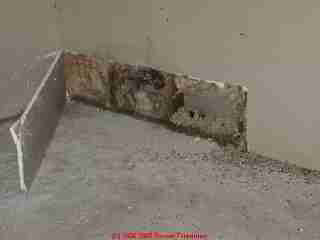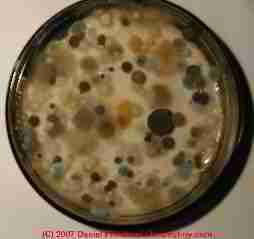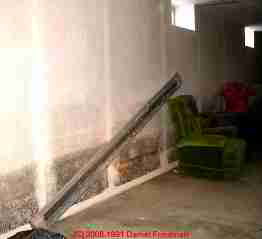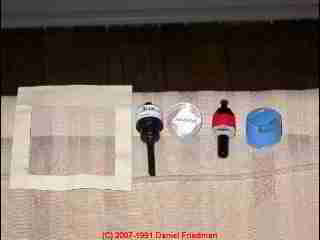 Indoor Air Quality &Toxic Mold & Toxic Gas Testing Methods Compared
Indoor Air Quality &Toxic Mold & Toxic Gas Testing Methods Compared
- POST a QUESTION or COMMENT about IAQ, Toxic Gas, & Indoor Mold contamination testing methods & procedures
Indoor air quality methods and methodology:
This article lists and compares classes of mold, air, gas, test methods used in indoor air quality investigation methodology in searching for possible causes of respiratory illness, asthma, immune system disorders, rashes, skin disease, psychological and neurological disorders, eye infections, or other symptoms which may have a physiological and environmental component.
Methods of inspection and testing building air quality for toxic mold, allergen or other sick house investigations, mold lab testing services, information on mold, mildew, moisture, pollen, dust mite, & environmental testing for home buyers, home owners, consultants, as well as a service to provide on-site field investigations and expert mold laboratory testing, and mold identification services are offered.
InspectAPedia tolerates no conflicts of interest. We have no relationship with advertisers, products, or services discussed at this website.
- Daniel Friedman, Publisher/Editor/Author - See WHO ARE WE?
Air Sampling Equipment & Mold Testing Protocols
 Links here organize the indoor air quality methods portion of our environmental website and take the reader
either directly to an in-depth article or to the collection of such articles addressing a particular environmental or IAQ topic.
Links here organize the indoor air quality methods portion of our environmental website and take the reader
either directly to an in-depth article or to the collection of such articles addressing a particular environmental or IAQ topic.
Air sampling equipment used for particle or mold sampling in buildings includes some useful, expensive tools, but if used alone, air sampling is not reliable for characterization of building conditions.
In short, a "negative" (no mold problem detected) result is not reliable because the level of airborne particles in indoor air varies by several orders of magnitude from minute to minute in a building. Waving a notebook, turning on or off a fan, opening a door, even walking across carpeting can completely change the level of airborne particles.
A mold inspector who relies only on tests and who omits thorough visual inspection, history taking, occupant interviews,etc. is not making a reliable mold-assessment of a building.
- ACCURACY OF AIR TESTS for MOLD - to test buildings for mold contaminatino: what are the limitations of this method?
- Burkard personal air sampler used by many residential investigators - http://www.burkard.co.uk/perssamp.htm
- Identification of Aero-allergens using he Burkard™ Spore Trap by D. Berman http://www.burkard.co.uk/perssamp.htm
- Other residential building sampling equipment e.g. at the Burkard website - http://www.burkard.co.uk/
- Alternative, low-cost air sampling equipment and methods such as the mini-vacuum pump and Zefon canisters
- Allergenco™ time-lapse impaction air sampling equipment - study changes in particle dispersion under varying conditions (furnace on/off)
- Protocols for Investigation of Indoor Airborne Fungal Amplifiers, R.C. Summerbell - http://members.aol.com/summerbelr/Richard3.htm
Bulk & Surface Tape Sampling Mold Testing Protocols
This photo shows some sampling devices we used in comparing the effectiveness of vacuuming a couch to test thick upholstered furnishings for mold contamination.
We collected comparison samples using different collecting devices as well as by using adhesive tape, for laboratory analysis.
Vacuuming furniture to test for mold contamination may be useful for general qualitative assessment when an expert has examined the building and its content.
Vacuuming building insulation may be the most reliable non-quantitative approach to detecting mold-contaminated fiberglass insulation.
Quantitative analysis of such samples is questionable.
Tape to collect mold or other surface sampling methods provide useful, inexpensive tools which, combined with careful visual inspection, are reliable and inexpensive for characterization of building conditions. Particles collected are very useful for genera and often mold species identification.
- TAPE & BULK SAMPLING & TESTS for MOLD: Tape lift from mold-covered surfaces; scrapes onto microscope slide and other methods also used by do-it-yourselfers and by experts
- TEST KIT for DUST, MOLD, PARTICLES: INSTRUCTIONS - using clear adhesive tape & plastic freeer-type storage bags
- Wall Check type vacuum pump and canister permits "sampling" of mold and allergens in wall, ceiling, and floor
cavities but our direct field testing indicates that this method is highly unreliable.
Working with Louis Relle, a Louisiana mold remediation expert on a New Orleans building which was to be demolished we collected wall-check samples from every suspect building cavity.
When the building interior surfaces were demolished we then performed a visual inspection and collected bulk surface samples using clear adhesive tape.
Watch out: The wall check samples were completely unable to detect large and significant mold contamination in the cavities of this building.
We postulate that even with mechanical agitation (banging on the wall during wall check sampling) the flow rate of the sampling method does not move enough air to reliably pick up surface contamination unless the mold genera/species happens to be at a particularly high state of active sporulation. The tool remains in the professional's arsenal, to be used with discretion.
Details are at VACUUMING BUILDING CAVITIES - Vacuum samples of carpeting, drapes, furniture, clothing permits testing for mold contamination.
We use this method for screening of areas where mold is not visible, and in clearance testing.
See VACUUM CASSETTE FILTER SAMPLE TESTS for DUST / MOLD
Cultures, Swabs, "Home Test Kits" Mold Testing Protocols
MOLD CULTURE TEST KIT VALIDITY describes the testing limitations or INVALIDITY of these methods for determining what contaminants are in a building -
Only about 10% of all molds will grow on any culture
medium whatsoever, and there are literally hundreds of culture media mycologists have developed to try to coax mold to grow in the laboratory.
90% wrong to start:
So the moment you open your "mold culture test kit" you're roughly 90% wrong in whatever conclusion you and your kit are going to reach. (We're exaggerating slightly because not all of the 1.5 million mold species will grow indoors in buildings anyway).
The mold that likes the culture media and grows on it may not be the mold that is a problem
in the building anyway - it may just be a nice marriage between what fell onto the plate and the chemistry of the mold growth media.
The rate that particles fall out of the air
has no reliable correlation to how many of them are in a building or where they're coming from.
So where's the mold?
The most troubling thing about this and some other mold test kits, when used by someone who's not an expert, is that even if the mold test kit indicates the presence of a problem mold, and even if the kit "got it right" in a particular case (that is, the mold it detected is actually the main problem in the building), we don't know where the problem is nor how big it is nor what to do about it.
Mold Sniffing Dogs as a Building Screen for Mold
Mold sniffing dogs are unreliable, though fun. For details,
see INEFFECTIVE MOLD PRODUCTS for an explanation of why mold sniffing dogs make poor mold detectives and why it's not good for them anyway.
There's no doubt that a dog can be trained to smell mold. What is the dog smelling? MVOCs.
Not all molds generate MVOCs,
and even molds that do generate MVOC's don't do so all the time. If the humidity, temperature, light, and other factors don't cause a particular MVOC-generating mold to release this gas, you're not going to detect it on the day of the inspection and test. Just later. Even if we detect MVOCs, is that the problem mold in the building?
Beagles are short
as dogs go - and are not good at sniffing out MVOC's that telltale a mold problem high in a building wall or in a ceiling.
Beagles are cute, though.
Infrared, Thermography, & MVOC Testing as a Building Screen for Mold
These good tools form a part of the arsenal of building investigation tools for many uses and problems, but they are unreliable as a building screen for mold.
IR and Thermography detect temperature differences, not mold. In short, IR, or thermography, which are wonderful and fun tools to use, only detect temperature differences. If your building has a mold problem in a wall or ceiling due to a leak that occurred a long time ago, the cavity may now be quite dry. The mold is happily growing along on ambient moisture, but the IR won't detect a thing.
IR and thermography are good at seeing leaky windows and doors, though. At one of our investigations a "mold killing" company had charged our client a few thousand dollars to "spray biocide into the moldy walls".
Our acquaintance who owns the company was excited with his new IR camera and used it as a "mold detector" - now this is a smart thing to do if you're looking for what building cavities have just gotten wet due to a leak.
But in this case what he detected was cool spaces around windows and doors - which is where he sprayed his biocide and "mold killer". When we cut open those walls we found absolutely no indication that there had ever been mold present, nor leaks, nor anything but lower temperatures. The mold problem (there was one) was in a completely different area of the home.
IR and thermography are great tools in the hands of an expert. They're not a mold detector.
For details see INEFFECTIVE MOLD PRODUCTS for an explanation of why this is so.
Sampling for Mold Volatile Organic Compounds - MVOCs and other Mold-Related Gases in buildings
Not all molds generate MVOCs, and even molds that do generate MVOC's don't do so all the time.
If the humidity, temperature, light, and other factors don't cause a particular MVOC-generating mold to release this gas, you're not going to detect it on the day of the inspection and test. Just later.
Where's the mold smell or musty odor problem source? Even if we detect MVOCs, is that the problem mold in the building? If we don't detect MVOC's does that promise there is no problem mold? No.
Please see MVOCs & MOLDY MUSTY ODORS for details about this topic.
Readers should also see MOLD ODORS, MUSTY SMELLS
and see MYCOTOXIN EFFECTS of MOLD EXPOSURE.
Production of toxins and microbial volatile organic compounds (MVOCs) by fungi in an environmental sample is dependent upon many factors, such as the substrate on which mold is growing, relative humidity and temperature in the moldy environment; the relative importance of each of these factors in toxin production is poorly understood.
Our GAS EXPOSURE SCREENING TEST describes gas testing procedures, instruments, detection limits, and it lists some of the toxic (or other) indoor gases for which we can test, depending on the building complaint and building conditions.
Good Mold Testing Laboratory and Microscope Procedures
TECHNICAL PROCEDURES describes proper mold testing laboratory procedures, and sample processing not by a "supervised" technician but by a qualified expert are critical in making sense of field samples.
Competent, trained, experienced aerobiologists, mycologists, and microbiologists can identify sample contents with good accuracy.
Depending on the experience of the laboratory, it is also possible to interpret the meaning of the sample for the building and its occupants.
Laboratory professionals who have also performed the field inspection can often offer useful interpretations of even low levels of certain particles or classes of particles found in indoor air or surface dust.
For example, if a field test for mold detects certain fungi not usually found on indoor surfaces, those molds may not themselves be a likely health hazard to building occupants, but they may be common water-indicators that suggest that further investigation of the building is in order to look for the presence other, more problematic molds that the initial investigation failed to detect.
Indoor Air / Toxic Mold Investigation Reports
MOLD INVESTIGATION REPORTS provides a document outlining what to look for in a toxic mold field investigation report or mold test laboratory report. we have been troubled that some very costly "mold investigators" simply collect a few air, culture, or swab samples, toss them over to a mold testing lab, and give their clients the lab report.
A valid and useful mold investigation needs to include a detailed visual inspection to identify problem sources, the presence and extent of a mold or other problem reservoir, and then it needs to provide the supporting lab work to justify what may be a costly cleanup (i.e. let's not spend a lot cleaning up "cosmetic" mold). The end product of the investigation needs to include the following
- Where are the problem mold or other reservoirs in the building?
- What is the extent of cleanup needed? Exactly where are the problems actually located?
- What do lab results indicate about toxicity, allergenicity, medical implications of potential exposure, and the need for expert cleaning services?
- What needs to be changed or fixed on the building to prevent a recurrence of the original problem?
What to do About Mold - Key Articles

- MOLD CONTAMINATION IN BUILDINGS - home, What to do about mold in buildings, when and how to inspect and clean up mold - detailed in-depth articles, well
organized, researched.
Taking a broad approach involves a site and building examination for probable sources of moisture, bioaerosols, other allergens, as well as dangerous conditions such as obviously blocked chimneys. This group of links outlines what to do about mold, when to hire a professional, and how to look for mold in buildings. - MOLD ACTION GUIDE an easy step-by-step outline of what to do about mold, how to including
- MOLD APPEARANCE - WHAT MOLD LOOKS LIKE
- MOLD TESTING METHOD VALIDITY an in-depth critique of popular mold testing methods -- Is your "mold expert" using valid methods? Is your mold test kit worth the bother?
- MOLD CLEANUP GUIDE- HOW TO GET RID OF MOLD
- MOLD RESISTANT CONSTRUCTION, article on how to prevent a mold problem now or in the future; or see our list of mold prevention articles
- DO IT YOURSELF MOLD CLEANUP -links listed at the ARTICLE INDEX the bottom of this article outline the topics you should address
- MOLD / ENVIRONMENTAL EXPERT, HIRE ? - helps decide if you should tackle a mold problem yourself or hire an expert to inspect, test, and advise on cleanup.
- MOLD CLEANUP GUIDE- HOW TO GET RID OF MOLD outlines valid and in-valid mold remediation methods
- INDOOR AIR QUALITY METHODS COMPARED helps readers sort through the various mold test services offered by a wide range of investigators
...
Continue reading at AIRBORNE PARTICLE ANALYSIS METHODS or select a topic from the closely-related articles below, or see the complete ARTICLE INDEX.
Or see these
Recommended Articles
- ACCURACY OF AIR TESTS for MOLD
- AIR QUALITY STUDY San Miguel de Allende
- AIRBORNE MOLD COUNT VALIDITY
- AIRBORNE MOLD SPORE COUNT GUIDE - home
- AIRBORNE PARTICLE LEVELS vs IAQ - home
- AIRBORNE PARTICLE ANALYSIS METHODS
- AIRBORNE PARTICLE COUNT VARIATION CAUSES
- AIRBORNE PARTICLE COUNT VARIATION EXTENT
- AIRBORNE PARTICLE SIZE DEFINITIONS & TYPES
- AIRBORNE PARTICLE SIZE TABLE
- DUST SAMPLING PROCEDURE
- FORENSIC INVESTIGATION of BUILDINGS
- FORENSIC LAB TECHNICAL PROCEDURES - home
- INDOOR AIR QUALITY METHODS COMPARED
- LAB PROCEDURES MICROSCOPE TECHNIQUES
- LAB & FIELD IAQ EQUIPMENT SOP
- MICROSCOPE SLIDE BULK SAMPLE PREP
- SWAB & PCR SAMPLING & TESTS for MOLD
- TAPE & BULK SAMPLING & TESTS for MOLD
- TEST KIT for DUST, MOLD, PARTICLES: INSTRUCTIONS
- VACUUM CASSETTE FILTER SAMPLE TESTS for DUST / MOLD
- VACUUMING BUILDING CAVITIES
Suggested citation for this web page
INDOOR AIR QUALITY METHODS COMPARED at InspectApedia.com - online encyclopedia of building & environmental inspection, testing, diagnosis, repair, & problem prevention advice.
Or see this
INDEX to RELATED ARTICLES: ARTICLE INDEX to BUILDING FORENSICS
Or use the SEARCH BOX found below to Ask a Question or Search InspectApedia
Or see
INDEX to RELATED ARTICLES: ARTICLE INDEX to BUILDING ENVIRONMENT
Or use the SEARCH BOX found below to Ask a Question or Search InspectApedia
Or see
INDEX to RELATED ARTICLES: ARTICLE INDEX to BUILDING INDOOR AIR QUALITY IAQ
Or use the SEARCH BOX found below to Ask a Question or Search InspectApedia
Or see
INDEX to RELATED ARTICLES: ARTICLE INDEX to MOLD CONTAMINATION & REMEDIATION
Or use the SEARCH BOX found below to Ask a Question or Search InspectApedia
Ask a Question or Search InspectApedia
Try the search box just below, or if you prefer, post a question or comment in the Comments box below and we will respond promptly.
Search the InspectApedia website
Note: appearance of your Comment below may be delayed: if your comment contains an image, photograph, web link, or text that looks to the software as if it might be a web link, your posting will appear after it has been approved by a moderator. Apologies for the delay.
Only one image can be added per comment but you can post as many comments, and therefore images, as you like.
You will not receive a notification when a response to your question has been posted.
Please bookmark this page to make it easy for you to check back for our response.
IF above you see "Comment Form is loading comments..." then COMMENT BOX - countable.ca / bawkbox.com IS NOT WORKING.
In any case you are welcome to send an email directly to us at InspectApedia.com at editor@inspectApedia.com
We'll reply to you directly. Please help us help you by noting, in your email, the URL of the InspectApedia page where you wanted to comment.
Citations & References
In addition to any citations in the article above, a full list is available on request.
- Roger Hankey is principal of Hankey and Brown Inspections, Winter Park, CO. Mr. Hankey is a past chairman of the ASHI Standards Committee and served in other ASHI chapter and national leadership roles. Mr. Hankey is a National Radon Proficiency Program certified measurement professional and a Level II infrared thermographer. Contact Roger Hankey at: 970-393-6604 - rogerhankey47@gmail.com . Website: www.HankeyandBrown.com Mr. Hankey is a frequent contributor to InspectAPedia.com.
- Arlene Puentes [Website: www.octoberhome.com ] , an ASHI member and a licensed home inspector in Kingston, NY, and has served on ASHI national committees as well as HVASHI Chapter President. Ms. Puentes can be contacted at ap@octoberhome.com
- In addition to citations & references found in this article, see the research citations given at the end of the related articles found at our suggested
CONTINUE READING or RECOMMENDED ARTICLES.
- Carson, Dunlop & Associates Ltd., 120 Carlton Street Suite 407, Toronto ON M5A 4K2. Tel: (416) 964-9415 1-800-268-7070 Email: info@carsondunlop.com. Alan Carson is a past president of ASHI, the American Society of Home Inspectors.
Thanks to Alan Carson and Bob Dunlop, for permission for InspectAPedia to use text excerpts from The HOME REFERENCE BOOK - the Encyclopedia of Homes and to use illustrations from The ILLUSTRATED HOME .
Carson Dunlop Associates provides extensive home inspection education and report writing material. In gratitude we provide links to tsome Carson Dunlop Associates products and services.


